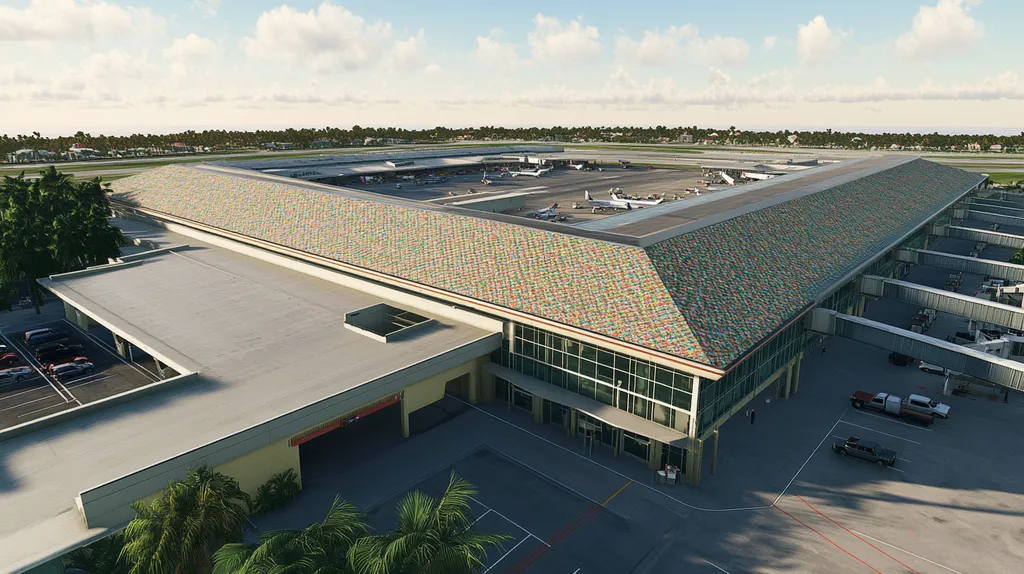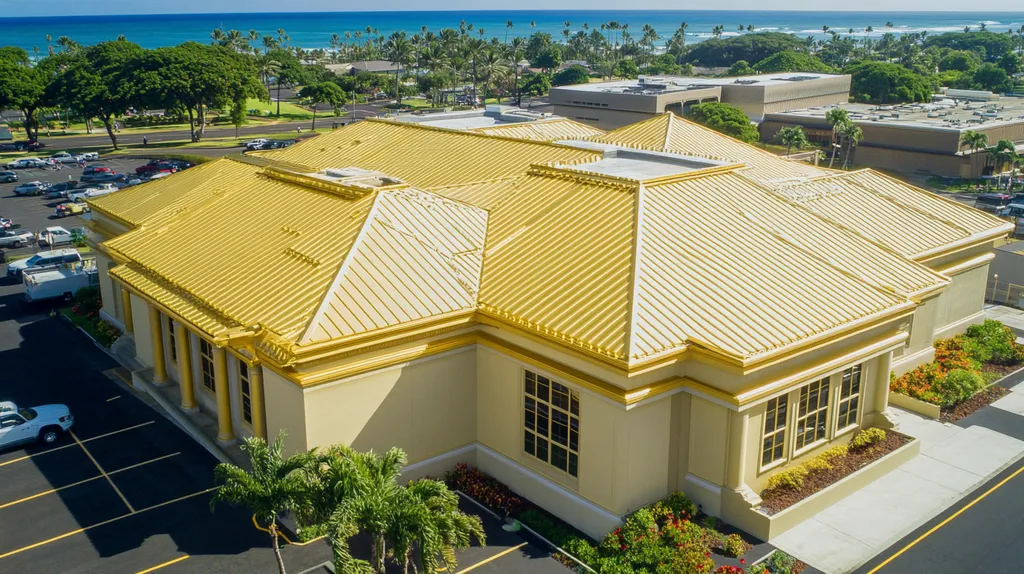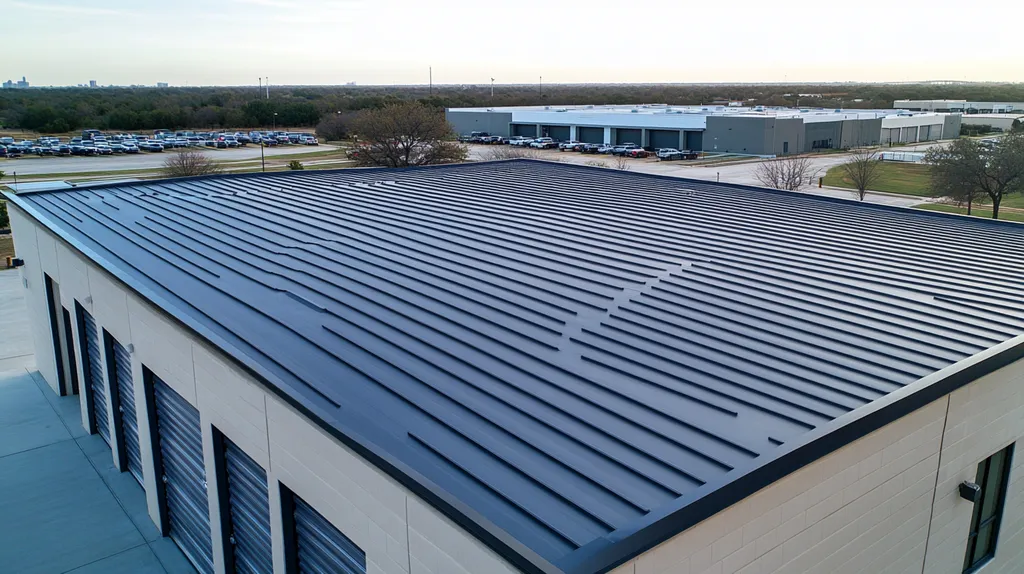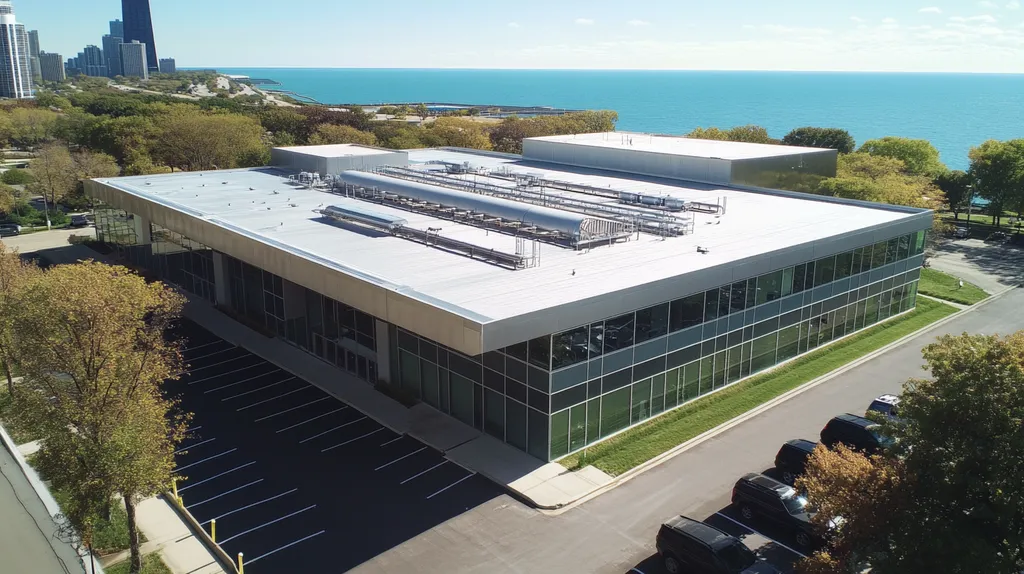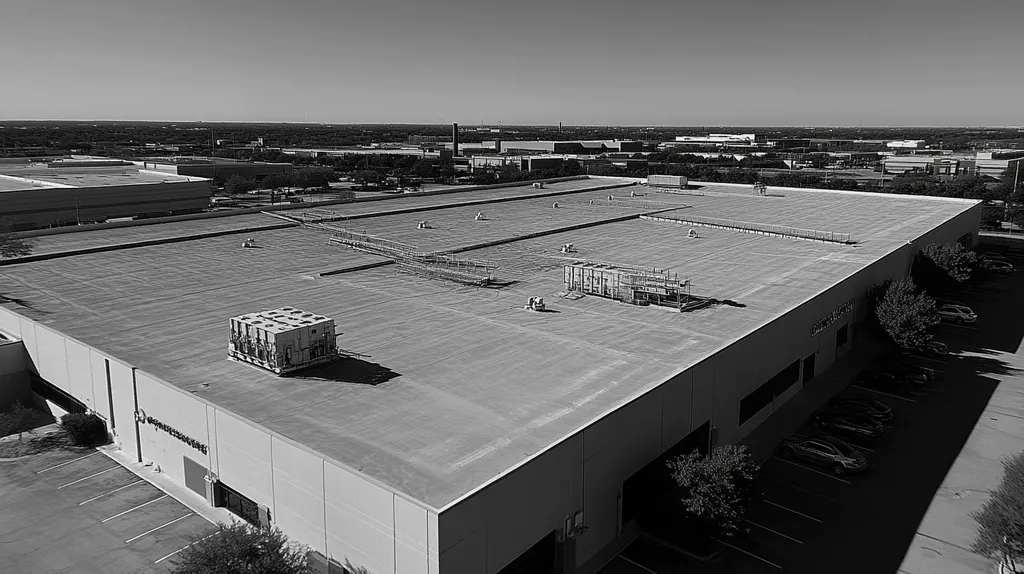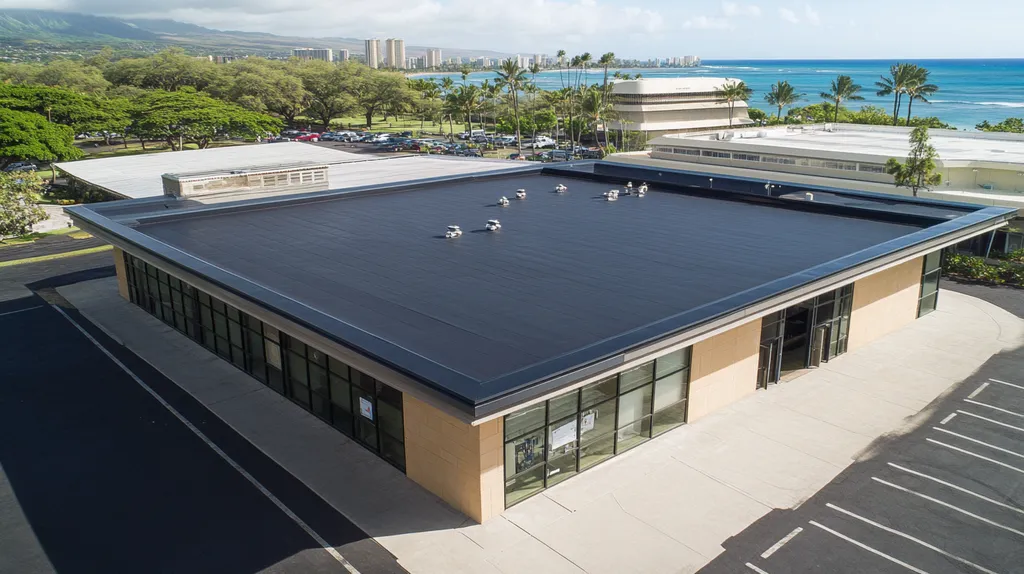As solar installations on commercial roofs surge by 40% annually, a disturbing trend emerges: one in four installations leads to costly roof damage within the first year due to inadequate inspections.
While the promise of renewable energy captivates property owners, the reality of integrating solar panels with existing roofing systems demands more attention than many realize.
From structural integrity concerns to moisture intrusion risks, the stakes couldn’t be higher for facility managers navigating this green energy transformation.
This comprehensive guide separates fact from fiction, offering clear, actionable insights for protecting both your roof and solar investment.
SECTION 1: COMMON MISCONCEPTIONS
The surge in solar panel installations on commercial roofs has sparked a wave of misunderstandings that could potentially lead to significant costs and headaches. Many property owners mistakenly believe that solar panels can be fitted on any roof without considering its unique characteristics and condition. This line of thinking can lead to disastrous results, including roof damage and reduced efficiency of solar systems. It’s essential to clarify these misconceptions to protect both the integrity of roofs and the effectiveness of solar energy investments.
Solar Panels Can Be Installed on Any Roof
One of the most persistent myths is that solar panels can simply be installed on any roof, regardless of its condition. This assumption ignores vital factors, such as roofing material, age, and structural strength. For example, older roofs may not hold the additional weight of solar panels, resulting in leaks or even structural failure.
Building codes and manufacturer specifications often outline which roofing materials are compatible with solar systems. If panels are affixed to an incompatible roof, it can void warranties and lead to unexpected expenses. Thus, a thorough evaluation of the roofing system is a must before any installation begins.
Moreover, different roof types, especially those with low slopes or specific materials, may require special mounting systems. Without this understanding, property owners could end up with inefficient or unsafe installations.
In short, a detailed assessment of the roof’s condition alongside its compatibility with solar technology is essential. Neglecting this crucial step can not only damage the roof but also jeopardize the entire investment in solar energy.
No Need for Pre-Installation Roof Inspections
Another widespread misconception is that pre-installation roof inspections are unnecessary. Many property owners think that once their solar system is designed, their roofs will seamlessly support the installation. However, this outlook can result in a host of unintended problems.
Pre-inspections play a critical role in uncovering underlying issues, such as signs of wear, water damage, or inadequate structural support. A seemingly minor leak can transform into a major issue after solar panels are installed, complicating repairs and escalating costs.
Additionally, thorough roof inspections aid in the planning of the installation process. Knowing the roof’s layout and condition allows solar installers to optimize panel placement for maximum energy efficiency, steering clear of shaded spots or structural constraints.
Ultimately, comprehensive pre-installation inspections safeguard the investment in solar energy and boost the roof’s overall functionality. Skipping this step can lead to higher long-term maintenance costs and diminished energy output.
Solar Installers Are Also Roofing Experts
Many believe that solar installers are roofing specialists capable of addressing all roofing concerns. While many solar professionals have a basic understanding of roofing, not all are trained to perform in-depth evaluations of roofing conditions. Relying solely on their insight can be misleading.
Roofing experts are trained to conduct detailed inspections that dig deeper than surface-level observations. They can uncover issues like moisture intrusion, structural weaknesses, and the long-term viability of roofing materials, which are crucial for the successful integration of solar panels.
Furthermore, roofing professionals can offer vital advice on necessary reinforcements or repairs before solar panels are installed. Overlooking these actions can lead to complications down the road, potentially affecting both solar performance and roof stability.
In summary, while solar installers are crucial to the installation process, their expertise should be complemented by that of roofing professionals. This collaborative approach ensures that both the roof and solar system function optimally for years to come.
SECTION 2: PRACTICAL IMPLICATIONS
The rise of solar installations on commercial roofs brings with it a set of serious challenges that property owners and facility managers must face head-on. Shocking findings show that 40% of commercial roofs experience leaks within just five years of adding solar panels. This statistic underscores the critical importance of thorough roof inspections to prevent costly damage and maintain roofing integrity.
Risks of Moisture Intrusion and Leaks
Moisture intrusion poses a significant risk with solar panel installations. If panels are installed or inspected inadequately, they can trap water underneath, leading to leaks that threaten the roof’s structural integrity. This risk escalates with flat roofs, where water accumulation can result in serious damage over time.
Unresolved leaks from poorly executed installations can give rise to mold growth, which not only threatens health but also inflates repair costs. Even the tiniest trickle can snowball into an expensive nightmare requiring extensive repairs, easily avoidable with proactive inspections.
Additionally, the weight of solar panels calls for diligent scrutiny of the roof’s drainage system. Without proper management, drainage issues can worsen, compounding moisture-related challenges. Regular inspections are vital for catching early signs of water intrusion and ensuring the roof’s long-term durability.
By prioritizing inspections around solar installations, property managers can protect against significant damage and maximize the lifespan of both the roof and solar system.
Impact on Roof Lifespan and Maintenance
The addition of solar panels can dramatically influence the lifespan of commercial roofs. While these panels have the advantage of shielding the roof from UV damage, they also introduce stress that may accelerate wear and tear. Without consistent inspections, even minor concerns can spiral into serious issues that shorten the roof’s longevity.
Furthermore, solar installations often require shifts in maintenance strategies. Many property owners mistakenly assume that solar panels minimize roof issues; however, routine maintenance must evolve to accommodate the complexities of solar components. For example, rooftop inspections and repairs may necessitate more time and specialized skills.
Building owners need to incorporate these maintenance considerations into their operational strategies to avoid rising costs. A proactive approach—integrating routine solar panel inspections—ensures both the roof and solar systems perform at their best.
Neglecting regular check-ups may lead to unexpected repair expenses and operational disruptions, all of which could easily be sidestepped with a commitment to stringent inspection protocols.
Structural Integrity and Load Capacity
Evaluating the structural integrity of a roof before solar panel installation is not just advisable; it’s essential. Roofs need a comprehensive assessment to confirm they can support the additional weight. Skipping this critical evaluation can lead to severe structural failures, jeopardizing the entire roof.
Industry standards dictate that a thorough evaluation precedes the installation of solar equipment. Property owners must work closely with roofing professionals to ensure this crucial assessment isn’t overlooked. Failure to do so could result in catastrophic consequences, compromising roof safety.
Reinforcing roofs during solar installations may be necessary to adequately bear the added weight, which can increase costs but is vital for long-term stability. Even minor adjustments to a roof’s load capacity can have far-reaching implications.
By prioritizing inspections and evaluating load capacity, facility managers can ensure that their roofs not only meet current safety standards but also remain protected against potential hazards, safeguarding their investments for years to come.
SECTION 3: COST OF MISINFORMATION
The financial implications of misinformation surrounding solar installations on commercial roofs can be staggering. Misjudging the integrity of a roof can create a cascade of costly repairs that drain time and resources. Property owners and facility managers face significant challenges when they fail to understand how roofing conditions directly affect solar panel performance. Being aware of these complexities is essential to protecting investments and preventing unforeseen expenses.
Additional Expenses for Roof Repairs
Misconceptions about roof conditions can skyrocket repair costs. For example, when solar panels are installed on a poorly maintained roof, hidden issues can intensify. Problems like water leaks, structural damage, and insulation issues are more likely, leading to steep repair bills.
Implementing a proactive inspection routine that considers solar installation can alleviate these expenses. By catching problems early, regular evaluations can prevent the need for costly interventions. Ignoring this practice can quickly turn minor repairs into major financial burdens.
Coordinating roofing and solar maintenance schedules is also a savvy strategy. For instance, conducting inspections after adverse weather events can spot potential issues before they exacerbate. This integrated approach not only conserves maintenance budgets but also extends the lifespan of both the roof and solar panels.
Failing to prioritize regular inspections shortens the lifespan of roofing systems and solar installations alike. Property owners who neglect maintenance end up grappling with soaring repair costs that could have easily been avoided.
Potential Damage to Solar Panels
Misjudging the state of a roof can also threaten the integrity of solar panels themselves. If leaks aren’t identified in time, water can breach the electrical components, reducing the solar array’s efficiency and possibly necessitating expensive replacements.
Additionally, without adequate insulation or ventilation, heat can build up excessively, leading to overheating. Solar panels that aren’t functioning optimally result in diminished energy yields, which directly impacts projected savings. Each lost kilowatt-hour translates to tangible financial losses.
Investing in a comprehensive inspection process can help mitigate these risks before they arise. Regular performance monitoring of solar panels and accompanying roof evaluations are essential to ensure that the systems operate in harmony rather than against each other.
Failing to recognize the connection between roof performance and solar efficiency can lead to significant long-term costs. Property owners must understand that investment in thorough assessments not only protects their solar assets but also optimizes energy production.
Compliance and Regulatory Issues
Misinformation can also spawn compliance and regulatory headaches. Many municipalities enforce stringent building codes for solar installations. If a facility manager mistakenly assumes their roof meets these requirements, they risk facing fines and project delays.
Moreover, improper installations can complicate insurance coverage. Insurers may refuse to pay for damages if roofs do not adhere to regulations, leaving property owners exposed to unexpected liabilities.
By prioritizing accurate inspections and deeply understanding regulatory requirements, facilities can steer clear of these pitfalls. Compliance checks ensure that solar installations align with all necessary codes and standards.
In the end, remaining vigilant about compliance issues means sidestepping potentially costly penalties. Thorough inspections not only guard against misinformation but also bolster a company’s integrity and reputation in the community.
SECTION 4: REALITY CHECK
Understanding the condition of a roof before solar installation is paramount. Shockingly, 25% of commercial roofs fail due to inadequate upfront assessments. Without careful evaluations, property owners face not just financial setbacks but also potential safety hazards. The stakes are high, as improper assessments can lead to costly repairs, unexpected delays, or even structural failures. This section delves into the critical need for thorough preliminary roof inspections, the evaluation of roof condition and load capacity, and the importance of comprehensive environmental and structural analyses.
Importance of Preliminary Roof Inspections
Preliminary roof inspections form the bedrock of successful solar installations. They provide an essential overview of the roof’s health and overall viability. Skipping these inspections can lead to costly oversights, such as hidden leaks or unnoticed structural weaknesses.
Addressing issues like membrane deterioration or water pooling before solar panel installation can save property owners thousands in future repair costs. Taking a proactive approach means problems can be resolved early, ensuring not only the longevity of the solar system but also the stability of the roofing structure.
Additionally, a thorough inspection checks for compliance with local building codes. This is vital for avoiding fines and guarantees that safety standards are upheld. Collectively, these factors contribute to a well-rounded, risk-free solar investment.
In short, comprehensive preliminary inspections lay the groundwork for successful solar integration. The roof must be in optimal condition to support the added weight and functionality of solar panels.
Assessing Roof Condition and Load Capacity
Properly evaluating roof condition and load capacity is a fundamental step. Not all roofs can bear the added weight of solar panels. Without suitable assessments, property owners risk installing systems that exceed their roof’s structural limits.
Common signs of distress, like sagging or blistering, require close examination. These indicators can unearth hidden issues that complicate solar installation, leading to significant liabilities if ignored.
Furthermore, determining load-bearing capacity aids in deciding the type and configuration of the solar system. This trustful data shapes both the installation process and the longevity of both the roof and the solar arrays.
Understanding these capacity constraints ensures that the roof can accommodate necessary components, including mounting hardware and wiring. Ignoring these crucial elements may lead to disastrous results, including roof failure long after installation.
Environmental and Structural Analysis
A thorough environmental and structural analysis plays a pivotal role in solar installation decisions. Factors like wind exposure, snow load, and local climate can significantly influence roof performance. All of these elements must be integrated into solar design and installation processes.
For instance, roofs in hurricane-prone areas require specialized mounting techniques to withstand high winds effectively. Neglecting these considerations can result in serious damage during storms, putting both the solar investment and building safety at risk.
Environmental factors, such as shading from nearby trees or structures, also impact solar efficiency. Analyzing these conditions allows for the optimal placement of solar panels to maximize energy production.
Ultimately, a detailed environmental and structural analysis customizes solar solutions for each specific building. This informed approach enhances system efficiency and aligns with best roofing practices, ensuring durability and sustainability for both the roof and solar installation.
SECTION 5: EVIDENCE-BASED ALTERNATIVES
As energy costs soar and sustainability becomes a pressing concern, integrating solar installations on commercial roofs has transformed from a mere trend into a necessity. With commercial buildings consuming nearly 20% of the nation’s energy, it’s crucial to approach solar system inspections, installations, and maintenance with a comprehensive strategy. This includes implementing rigorous roof inspection protocols, selecting the ideal solar panels and mounts, and reinforcing roof structures to support these systems effectively. By addressing these essential components, property owners can ensure that their solar installations remain efficient and sustainable for years to come.
Comprehensive Roof Inspection Protocols
Before diving into any solar installation, conducting a thorough roof inspection is non-negotiable. This crucial step identifies existing issues—like leaks or structural weaknesses—that could undermine performance. By adhering to a robust inspection protocol, property owners can pinpoint potential problems early and avoid costly repairs down the road.
The inspection process should assess membrane integrity, drainage performance, and the presence of debris. These elements can significantly impact the roof’s lifespan and the solar panels’ efficiency, ensuring that solar systems have a solid foundation.
Moreover, scheduling regular post-installation inspections is equally important. These follow-up checks confirm that solar equipment remains securely mounted and operates as intended. One-time inspections won’t cut it; ongoing monitoring is essential for preventing unexpected complications.
In summary, comprehensive roof inspections act as the front line against performance issues. They not only offer peace of mind but also ensure that investments in solar energy yield optimal returns while prolonging the roofing system’s life.
Selecting the Right Solar Panels and Mounts
Choosing suitable solar panels and mounting systems is pivotal in reaping the full benefits of solar energy. Not all solar panels deliver the same energy output, so property owners should scrutinize efficiency ratings, warranties, and manufacturer reputations.
The mounts that secure solar panels can also greatly affect installation success. Roof-mounted systems should feature durable brackets designed to endure high winds and varying environmental conditions. For flat roofs, consider ballasted mounts, while sloped roofs call for secure anchor points.
Properly matching panel sizes to the roof’s layout is fundamental. Mismatched panels can cause shading issues that dramatically reduce energy output. A careful selection process should account for current energy needs as well as future demands.
Investing enough time to understand the diverse solar panel options and compatible mounting methods ensures a high-performing installation, ultimately leading to meaningful energy cost savings.
Reinforcing Roof Structures for Solar Support
The addition of solar installations on commercial roofs adds considerable weight, necessitating structural reinforcement for safety and stability. A common error is overlooking the assessment of the existing roof structure’s load-bearing capacity prior to installation.
For flat roofs, evaluating the joist layout and implementing proper materials for reinforcement is essential. Older buildings may need additional beams or trusses to effectively support the solar array. This upfront investment in structural integrity is vital to prevent severe accidents and costly repairs later on.
Increasing the weight load can also impact drainage efficiency. Retrofit solutions may be required to properly redirect water flow. Engaging a structural engineer for evaluation and recommendations guarantees the roof can handle new loads without compromising its integrity.
By prioritizing structural reinforcement, property owners can establish solar energy systems that not only function proficiently but also safeguard against structural failures, protecting the longevity of both the roof and the solar installation for years to come.
SECTION 6: TEST AND VERIFY
With the rapid rise of solar installations on commercial roofs—over 30% growth in just the past year—property owners must prioritize thorough inspection and maintenance processes. Without diligent testing and verification, the risk of costly damages and operational disruptions looms large. Ensuring that solar systems are correctly installed, compliant, and well-maintained is essential for both safeguarding investments and maximizing energy efficiency.
Post-Installation Inspection Procedures
After solar panels are installed, conducting a detailed post-installation inspection is not just advisable—it’s essential. This inspection should closely examine the integrity of the roofing membrane, carefully checking for leaks or punctures that might have occurred during installation.
Inspectors also need to confirm that mounting systems are securely fastened and that panels are perfectly aligned. Proper alignment helps prevent wind uplift and water intrusion, two threats that can cause significant damage down the line.
Utilizing tools like thermal imaging can reveal hidden insulation issues or hot spots that are invisible to the naked eye. Identifying these problems early allows for prompt intervention, preventing small issues from ballooning into costly repairs.
Documentation is critical; all findings—including photographs and measurements—should be carefully recorded. This creates accountability and provides a valuable reference for future maintenance needs, ensuring that the solar system continues to operate at peak efficiency.
Regular Maintenance and Monitoring
To ensure longevity for both the roof and solar installation, regular maintenance is a must. Scheduling inspections at least twice a year is a smart strategy for catching minor issues before they snowball into major headaches.
Facilities managers should carry out structural assessments focusing on the roof’s condition, looking for vegetation, debris, or any damage to solar mounts. Keeping the roof clean is essential not only for aesthetics but also to prevent excess weight that could lead to roof failure.
Implementing monitoring systems to track energy production is also wise. These systems can quickly flag anomalies, such as a dip in performance that may indicate a problem with the solar panels or their mounting system.
By indeed prioritizing regular maintenance, property owners can ensure optimal energy production while protecting their investment throughout the system’s lifespan. This ongoing care will help reinforce the roof’s integrity and bolster overall building performance.
Compliance with Local Building Codes and Regulations
Compliance with local building codes and regulations isn’t just recommended; it’s crucial for safe operation. Each region has specific guidelines dictating how solar installations are to be conducted, ensuring the safety of the structure and its occupants.
Property owners must familiarize themselves with local requirements to avert fines or the potential removal of non-compliant systems. Codes often cover critical areas such as structural load limits, electrical configurations, and fire safety measures.
Working closely with licensed professionals who understand these regulations is vital. They can guarantee that installations adhere to or exceed all standards, protecting property owners from future liabilities.
Staying current with ever-changing regulations will streamline necessary adjustments, reducing risk and increasing operational reliability for all stakeholders involved.
Looking Ahead
With solar installations projected to double in the next five years, the stakes for proper inspection protocols have never been higher.
Industry data shows that facilities following rigorous inspection programs see 85% fewer roof-related issues and save an average of $2.75 per square foot in long-term maintenance costs.
The message is clear: successful solar integration demands more than just quality panels and skilled installers.
It requires a comprehensive approach that includes thorough pre-installation assessments, regular monitoring, and strict adherence to building codes.
By embracing these evidence-based practices, property owners can protect their investments while advancing toward a more sustainable future – but only if they act now to implement proper inspection protocols.
FREQUENTLY ASKED QUESTIONS
Q. Can solar panels be installed on any commercial roof?
A. It’s a common myth that solar panels fit any commercial roof. Various factors, like the roof’s age and material, affect compatibility. A thorough assessment is essential to avoid damaging your roof and ensure the solar system’s efficiency.
Q. What risks do moisture intrusion pose to industrial roofs with solar panels?
A. Moisture intrusion can cause severe issues on industrial roofs, including leaks and mold growth. Inadequate installation or inspection can trap water, leading to costly repairs. Regular checks help identify early signs of water-related problems, safeguarding the roof’s integrity.
Q. How can poor roof conditions lead to additional expenses after solar panel installation?
A. If the roof is in poor condition before installing solar panels, hidden issues can worsen, leading to expensive repairs later. Regular inspections can catch problems early, preventing minor issues from escalating into major financial burdens.
Q. Why are preliminary roof inspections important for commercial solar installations?
A. Preliminary inspections assess the roof’s health, identifying potential problems before solar installation. Skipping this step can lead to uncovered leaks and structural weaknesses, which may cost thousands in future repairs. Proactive evaluations ensure a solid foundation for solar systems.
Q. How can selecting the wrong solar panels affect my commercial roof?
A. Choosing unsuitable solar panels can lead to inefficiencies and higher energy costs. Mismatched sizes can create shading issues that harm energy output. It’s crucial to select high-quality panels with appropriate mounting systems to ensure optimal solar performance.
Q. What regular maintenance is necessary for solar installations on commercial roofs?
A. Regular maintenance includes checking for debris, inspecting panel alignment, and assessing roof condition. Scheduling inspections twice a year can help catch minor issues early, ensuring the solar system operates efficiently while protecting the roof’s integrity.
Q. How do local building codes impact solar installations on industrial roofs?
A. Local building codes dictate how solar installations must be executed, ensuring safety and compliance. Failure to follow these guidelines can result in fines and operational issues. Collaborating with licensed professionals helps guarantee adherence to all applicable regulations.

